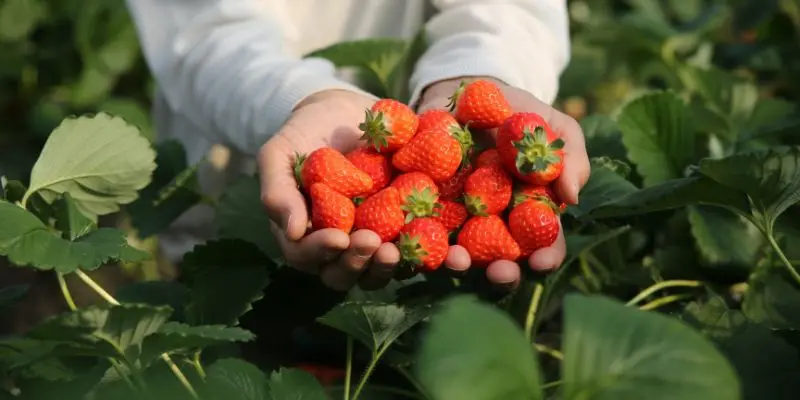How Strawberry Harvesting Got a High-Tech Boost in the U.S.
Published: 22 Apr 2025
Strawberry farming in the United States is known for being highly labor-intensive. Strawberries must be picked by hand when perfectly ripe, which requires speed, precision, and care. Traditionally, this work has been done by human laborers, but in recent years, the industry has been facing serious labor shortages, especially in California—the leading strawberry-producing state.

To address this challenge, several agricultural technology companies have developed robotic strawberry harvesters. These high-tech machines are designed to detect, assess, and pick strawberries autonomously using advanced robotics, computer vision, and artificial intelligence (AI). This innovation is now transforming how strawberries are harvested in the U.S., offering solutions to critical workforce and efficiency issues.
So, guys, without wasting time, let’s jump into the article to learn the How Strawberry Harvesting Got a High-Tech Boost in the U.S.
1. The Problem: Labor Shortages in Agriculture
Manual strawberry picking is a demanding task. It involves long hours in the field, bending over rows of plants to harvest delicate fruit. In recent years, fewer workers have been available or willing to take on this work.
Key factors contributing to the labor shortage include:
- Tougher immigration laws and fewer migrant workers
- Aging agricultural workforce
- Rising competition from less demanding industries
- Impact of the COVID-19 pandemic on labor mobility
As a result, many farms have struggled to harvest their crops in time, leading to economic losses and food waste.
2. The Innovation: Robotic Strawberry Harvesters
To tackle the labor crisis, companies such as Advanced Farm Technologies developed robots like the T-6 harvester, specifically designed to harvest strawberries.
Key features of the T-6 robotic harvester:
- Uses cameras and sensors to detect ripe strawberries
- Employs AI algorithms to make picking decisions
- Gently removes strawberries using soft-touch robotic arms
- Moves autonomously down rows, adapting to field conditions
The T-6 can pick up to 100 pounds of strawberries per hour. It operates continuously and is capable of working during both day and night shifts.

Sources: The Packer, MollyCruse.com
3. Benefits of Robotic Harvesting
A. Efficiency
- Robots do not get tired and can operate longer than humans.
- They maintain consistent speed and precision throughout the day.
- Fewer workers are needed, reducing dependency on seasonal labor.
B. Precision and Reduced Waste
- Robotic arms gently pick only ripe fruit, minimizing bruising or damage.
- Fewer mistakes mean better quality produce and longer shelf life.
C. Real-Time Data Collection
- Robots gather data on yield, ripeness, crop health, and field conditions.
- This helps farmers make better decisions for planting, irrigation, and harvesting in future seasons.
4. Environmental and Economic Impact
Environmental Benefits:
- Less crop waste due to timely and accurate harvesting
- Reduced need for chemical treatments since harvesting is more precise
- Lower fuel emissions with fewer trips through the field
Economic Benefits:
- High initial investment, but significant savings over time
- Decreases reliance on a shrinking labor pool
- More predictable harvest schedules lead to less spoilage and improved supply chain efficiency
In 2020, Advanced Farm Technologies secured $7.5 million in funding to expand the development and use of their robotic systems.
5. Future Outlook
The current generation of strawberry-harvesting robots is just the beginning. As technology evolves, these systems are expected to:
- Become more affordable for small and medium-sized farms
- Use more advanced AI for better fruit detection and learning from experience
- Expand to other crops such as blueberries, tomatoes, and grapes
- Integrate with drones, sensors, and farm management systems for a fully automated smart farm
Eventually, a hybrid model combining human workers and smart machines is expected to become the norm.
Conclusion
Robotic strawberry harvesters represent a major advancement in U.S. agriculture. By addressing labor shortages, improving harvest quality, and enabling data-driven decision-making, these machines offer a sustainable solution for modern farming.
Although initial costs are high, the long-term benefits in efficiency, productivity, and environmental impact make robotic harvesting a game-changing innovation. As the technology matures, it is likely to become an essential part of future farming operations.
References
Strawberry harvesting in the U.S. has received a high-tech upgrade through the use of AI-powered robotic systems. These innovations help combat labor shortages and improve harvesting speed and precision.
Here is the official report Regarding How Strawberry Harvesting Got a High-Tech Boost in the U.S.
Author Name.
Anushi,Mrs. Ravinder Kaur
Introduction, Scope, Importance, Nutritive Values and History of
Strawberry

- Be Respectful
- Stay Relevant
- Stay Positive
- True Feedback
- Encourage Discussion
- Avoid Spamming
- No Fake News
- Don't Copy-Paste
- No Personal Attacks

- Be Respectful
- Stay Relevant
- Stay Positive
- True Feedback
- Encourage Discussion
- Avoid Spamming
- No Fake News
- Don't Copy-Paste
- No Personal Attacks





